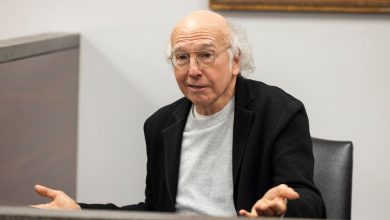Three Great Documentaries to Stream

The proliferation of documentaries on streaming services makes it difficult to choose what to watch. Each month, we’ll choose three nonfiction films — classics, overlooked recent docs and more — that will reward your time.
‘Sympathy for the Devil’ (1970)
Rent it on Amazon and Apple TV.
The most well-known documentary to center the Rolling Stones is almost certainly “Gimme Shelter,” the Maysles brothers’ chronicle of the band’s 1969 concert at Altamont Speedway, a movie that infamously captured the fatal stabbing of a concertgoer. But the weirdest documentary the Stones have appeared in is “Sympathy for the Devil,” first shown in 1968. The director was none other than Jean-Luc Godard, in the process of pivoting between the brilliance of “Weekend” and the barely watchable politicized films he would make with what was called the Dziga Vertov Group. In the recent documentary “Godard Cinema,” “Sympathy for the Devil” is held up as the director’s last bourgeois film before the rupture.
Far more interested in process than product, “Sympathy for the Devil” cuts back and forth between the Stones in the recording studio as they refine what would become one of their best-known songs, and scattered material that Godard shot around London. The studio sessions are hypnotic; the camera tracks around the room in lengthy shots as the Stones try to find a groove, although they’re often undercut by metallic-sounding voice-over from what Roger Greenspun, reviewing the film for The New York Times in 1970, described as a “now famous pornographic political novel,” whose text Godard uses as an alienation effect.
In between clips of the band, Godard intersperses various provocations: scenes of Black militants operating from a junkyard by the Thames; a bizarre interlude at a book and magazine shop where a man in Elton John-style glasses reads from “Mein Kampf,” and heiling Hitler appears to be part of the checkout procedure; and Godard’s then-wife, Anne Wiazemsky, playing a person called Eve Democracy, who responds yes or no — mostly yes — to nonsensical questions from a television reporter. Graffiti and hand-painted title cards engage in Godard’s customary wordplay, albeit this time in English (“FBI + CIA = TWA + PANAM”). An unbroken closing shot exposes the machinery of tracking, craning and tilting.
The version streaming is technically not Godard’s. His was titled “1 + 1” (or “One Plus One,” or “One + One,” depending on your source), ostensibly after the idea of putting contradictory ideas together. It did not play the Stones’ completed song all the way through at the end. Richard Brody’s comprehensive Godard book “Everything Is Cinema” gives an account of how the two versions of the film were at one point meant to be screened in counterpoint at the 1968 London Film Festival. In New York, “Sympathy for the Devil” and “1 + 1” alternated days. “If you go on Monday, Wednesday, Friday or Sunday, you will see Godard’s film,” Greenspun wrote.
‘The Last of the Unjust’ (2014)
Stream it on Kanopy. Rent it on Amazon, Apple TV, Kino Now and Vudu.

The Times critic A. O. Scott reviews “The Last of the Unjust.”CreditCredit…Cohen Media Group
“The Last of the Unjust” is one of several films by Claude Lanzmann (1925-2018) that can be considered an offshoot of “Shoah” (1985), his nine-and-a-half hour film on the Holocaust that, for many, represents the finest cinematic statement on the subject. “The Last of the Unjust,” completed almost three decades later, revolves around a set of interviews that Lanzmann conducted in Rome in 1975 with a former Vienna rabbi named Benjamin Murmelstein.
Murmelstein was the final chairman of what the Nazis called the Jewish Council at Theresienstadt, the show camp that they had established outside Prague to parade their ostensibly humane treatment of the Jews before the world. He essentially functioned as an intermediary between the Jews and the Nazis at the camp. Inevitably, after the war, he was accused of collaboration. Murmelstein’s description of his role is a bit different. He says that a council’s “elder” (the Germans’ term, which Lanzmann notes had tribal connotations) was always “between the hammer and the anvil.” Murmelstein adds, “The person in that position can deaden a lot of blows.”
Exactly how many blows he deadened, how he did it and why are the essential questions that Lanzmann teases out over the course of the film. Murmelstein, who in Vienna had already been assigned by Adolf Eichmann to investigate the topic of emigration, had the opportunity to flee to London in 1939 and didn’t. “Do you want me to admit that I felt I had a mission to carry out and that’s why I didn’t leave?” he asks Lanzmann. “Does that seem so strange?” He volunteers that he had what he calls a “thirst for adventure” and doesn’t deny a taste for power. But if his position meant he could get more visas for more Jews from the British consul, so much the better.
He vigorously pushes back against Hannah Arendt’s description of Eichmann as embodying the “banality of evil.” (“He was a demon,” Murmelstein says.) His recollections of Theresienstadt become, in effect, the story of his efforts to bolster the Nazis’ propaganda efforts in order to save more lives by saving the camp. “If they hid us, they could kill us,” he says. “If they showed us, they couldn’t. Logical!” That 33,000 Jews died at Theresienstadt, according to the United States Holocaust Memorial Museum, might give some sense of the grim calculus he was facing.
Lanzmann, who supplements the 1975 conversations with then-present-day visits to the sites in question, clearly likes Murmelstein, who died in 1989. The film’s parting note — with the men walking off in friendship — only adds to the complexity of the emotions the movie evokes.
‘Street Gang: How We Got to Sesame Street’ (2021)
Stream it on Max. Rent it on Google Play and Vudu.
Last month in The Times, Sopan Deb got the scoop on how Cookie Monster’s cookies are made. What happens behind the scenes of “Sesame Street” is an endless source of curiosity — not least because most of its viewers watch it before they’ve begun to think about how television programs are made.
“Street Gang: How We Got to Sesame Street,” a documentary from Marilyn Agrelo (“Mad Hot Ballroom”), takes its cues and its title from a book by Michael Davis. But you can’t really tell the story of “Sesame Street” without clips, and that makes this documentary tough to resist. Who today — or ever, really — would think to harness tried-and-true methods of advertising and turn them toward educational ends? “Every child in America was singing beer commercials,” says Joan Ganz Cooney, the first executive director of the Children’s Television Workshop. “Now where had they learned beer commercials?”
Jon Stone, a longtime writer, producer and director on the show, recalls that the idea for the brownstone set came from a commercial for the Urban Coalition. (The reasoning being that any city kid would know that the streets are more fun than being cooped up upstairs.) The show depicted a multiracial neighborhood long before it was fashionable to show one on TV. And some of the most fascinating tidbits recounted in the film deal with the sensitivity of “Sesame Street” to children’s psychology. When the actor Will Lee, who played Mr. Hooper, died, the show’s creators made Mr. Hooper’s death a part of the show, in part because to do otherwise would have broken the program’s ethos of being truthful to children.




